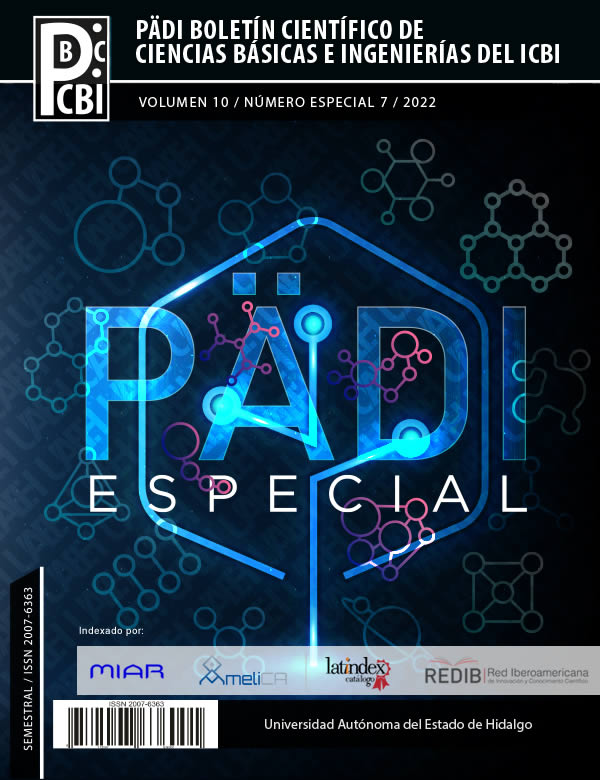Peptide nanoencapsulation
Nanoencapsulated peptides
Abstract
Bioactive peptides are short sequences of amino acids that come from protein hydrolysis, remain inactive when the protein is complete, and acquire their activity when released. Bioactive peptides are relevant in the metabolic functions of organisms. The functions of some bioactive peptides with therapeutic applications for humans have been identified, among which their antimicrobial, antithrombotic, and antihypertensive functions stand out, among others, in addition to their use as a preventive treatment. One way to protect the activity of bioactive peptides for administration is the nanoencapsulation technique through which nanoscale particles with a protective barrier are generated. This article is a review of the peptide nanoencapsulation technique and includes some physical characteristics to consider for the finished product such as encapsulation efficiency (EE) and morphology determination
Downloads
References
Agyei, D., Ongkudon, C.M., Wei, C.Y., Chan, A.S., Danquah, M.K., (2016). Bioprocess challenges to the isolation and purification of bioactive peptides. Food and Bioproducts Processing. 1-42. DOI:10.1016/j.fbp.2016.02.003
Akbarzadeh, A., Rezaei-Sadabady, R., Davaran, S. et al. (2013). Liposome: classification, preparation, and applications. Nanoscale Research Letters. 8: 102. DOI:10.1186/1556-276X-8-102
Allen, T. M., & Cullis, P. R. (2013). Liposomal drug delivery systems: from concept to clinical applications. Advanced Drug Delivery Reviews. 65(1), 36–48. DOI:10.1016/j.addr.2012.09.037
Assadpour, E & Jafari, SM. (2019). Nanoencapsulation: Techniques and developments for food applications. In Nanomaterials for Food Applications. 35–61. DOI:10.1016/B978-0-12-814130-4.00003-8
Bayraktar, O., Erdoğan, I., Köse, MD., Kalmaz, G. (2017). Nanocarriers for plant-derived natural compounds. In: Nanostructures for Antimicrobial Therapy. 395-412. DOI:10.1016/B978-0-323-46152-8.00017-2.
Da Rosa Zavareze, E., Telles, A.C., El Halal, S.L.M., Da Rocha, M., Colussi, R., De Assis, L.M., Suita de Castro, L.A., Guerra Dias, A.R., Prentice-Hernández, C. (2014). Production and characterization of 23 encapsulated antioxidative protein hydrolysates from Whitemouth croaker (Micropogonias furnieri) muscle and byproduct. LWT-Food Science and Technology. 59: 841-848. DOI:10.1016/j.lwt.2014.05.013
He, S., Mao, X., Zhang, T., Guo, X., Ge, Y., Ma, C., & Zhang, X. (2016). Separation and nanoencapsulation of antitumor peptides from Chinese three-striped box turtle (Cuora trifasciata). Journal of Microencapsulation. 33(4): 344–354. DOI:10.1080/02652048.2016.1194904
Hosseini, S. F., Ramezanzade, L., & Nikkhah, M. (2017). Nano-liposomal entrapment of bioactive peptidic fraction from fish gelatin hydrolysate. International Journal of Biological Macromolecules. 105: 1455–1463. DOI:10.1016/j.ijbiomac.2017.05.141
Ibrahim, Y., Regdon, G., Jr, Hamedelniel, E. I., & Sovány, T. (2020). Review of recently used techniques and materials to improve the efficiency of orally administered proteins/peptides. DARU: Journal of Pharmaceutical Sciences. 28(1): 403–416. DOI:10.1007/s40199-019-00316-w
Jafari, S.M., (2017). Chapter 1-an introduction to nanoencapsulation techniques for the food bioactive ingredients. In: Nanoencapsulation of Food Bioactive Ingredients. Academic Press. pp. 1-62.
Khorasani, S., Danaei, M., Mozafari, M.R. (2018). Nanoliposome technology for the food and nutraceutical industries. In: Trends in Food Science & Technology. 79:106-115. DOI: 10.1016/j.tifs.2018.07.009
Latorres, J. M., Aquino, S., da Rocha, M., Wasielesky J. W., Martins, V. G., Prentice, C. (2021). Nanoencapsulation of white shrimp peptides in liposomes: Characterization, stability, and influence on bioactive properties. Journal of Food Processing and Preservation. 45(7): 1-11. DOI:10.1111/jfpp.15591
Leader B, Baca Q.J., Golan, D.E. (2008). Protein therapeutics: a summary and pharmacological classification. Nature Reviews Drug Discovery, 7:21–39. DOI:10.1038/nrd2399
Lowry, O.H., Rosebrough, N.J., Farr, A.L., Randall, R.J. (1951) Protein measurement with the Folin phenol reagent. Journal of Biological Chemistry. 193: 265-275.
Mosquera, M., Giménez, B., Montero, P., Gómez-Guillén, MC. (2016). Incorporation of liposomes containing squid tunic ACE-inhibitory peptides into fish gelatin. The Journal of the Science of Food and Agriculture. 96(3): 769-776. DOI:10.1002/jsfa.7145
Noorbatcha, I.A., Jaswir, I., Ahmad, H. (2017). Nano-encapsulation of proteins and peptides. Current Nanomaterials. 2(2): 76-83. DOI:10.2174/2405461502666170912100212.
Owens, D. E., 3rd, & Peppas, N. A. (2006). Opsonization, biodistribution, and pharmacokinetics of polymeric nanoparticles. International Journal of Pharmaceutics. 307(1): 93–102. DOI:10.1016/j.ijpharm.2005.10.010
Perry, S. L., McClements, D. J. (2020). Recent advances in encapsulation, protection, and oral delivery of bioactive proteins and peptides using colloidal systems. Molecules. 25(5): 1161–DOI:10.3390/molecules25051161
Rajanna, D., Pushpadass, H.A., Emerald, F.M.E., Padaki, N.V. and Nath, B.S. (2021), Nanoencapsulation of casein-derived peptides within electrospun nanofibres. The Journal of the Science of Food and Agriculture. 102: 1684-1698. DOI:10.1002/jsfa.11509
Sánchez, A & Vázquez, A. (2017). Bioactive peptides: A review. Food Quality and Safety. 1(1): 29–46. DOI:10.1093/fqsafe/fyx006
Shin, G.H., Kim, J.T., Park, H.J., (2015). Recent developments in nanoformulations of lipophilic functional foods. In: Trends in Food Science & Technology. 46 (1): 144-157. DOI: 10.1016/j.tifs.2015.07.005
Sorolla A, Sorolla MA, Wang E, Ceña V. (2020). Peptides, proteins and nanotechnology: a promising synergy for breast cancer targeting and treatment. Expert Opinion on Drug Delivery. 17(11):1597-1613. DOI: 10.1080/17425247.2020.1814733
Witika, B. A., Makoni, P. A., Matafwali, S. K., Chabalenge, B., Mwila, C., Kalungia, A. C., Nkanga, C. I., Bapolisi, A. M., & Walker, R. B. (2020). Biocompatibility of biomaterials for nanoencapsulation: Current approaches. Nanomaterials (Basel, Switzerland), 10(9): 1649. 1-40. DOI.:10.3390/nano10091649













